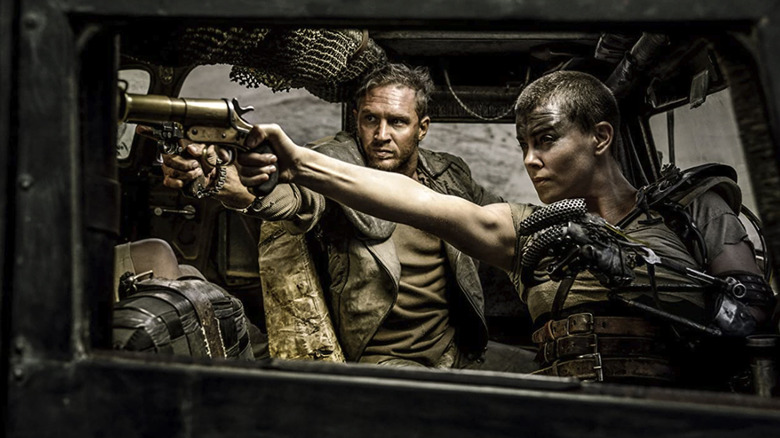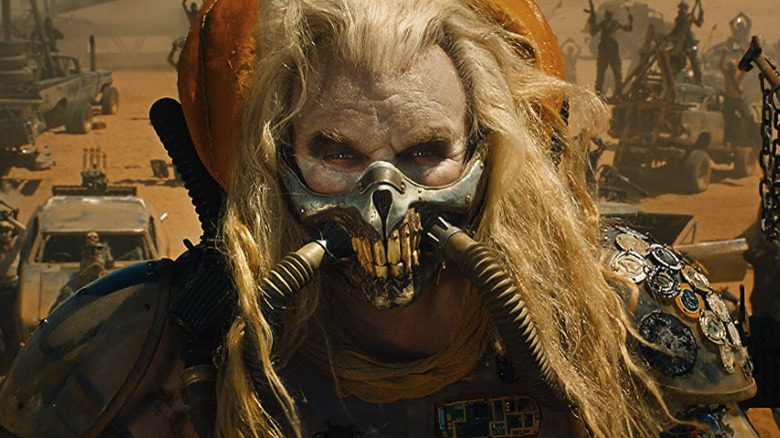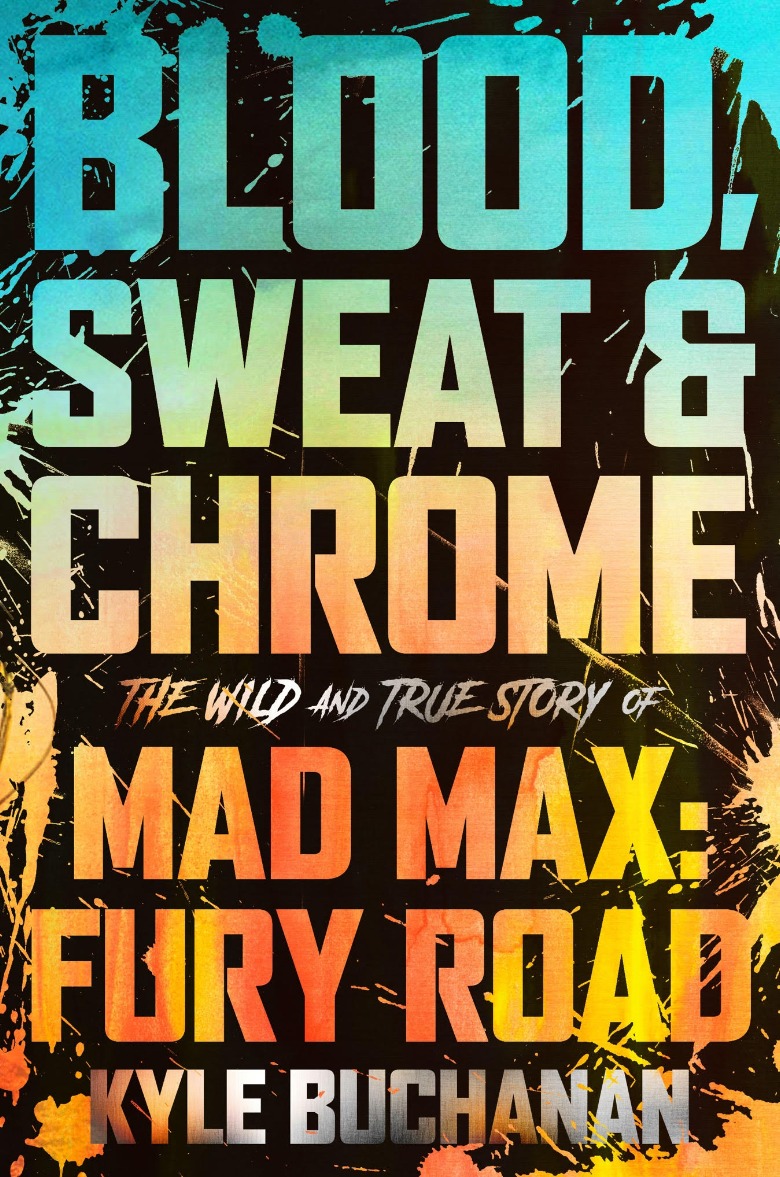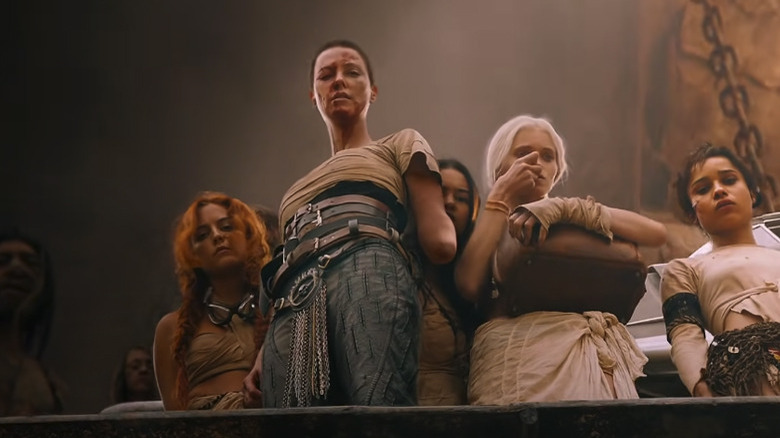Author Kyle Buchanan On The Wild And True Story Of Making Mad Max: Fury Road; Read An Excerpt [Interview]
"Mad Max: Fury Road" is undeniable. It's one of the most bombastic, breakneck, dangerous, jaw-dropping, and downright ambitious movies ever made, and the story of how it came together is just as compelling as the movie itself.
In his new book, "Blood, Sweat & Chrome: The Wild and True Story of Mad Max: Fury Road," New York Times writer Kyle Buchanan interviewed director George Miller, stars Charlize Theron and Tom Hardy, and over 150 more people involved with the making of the movie, resulting in an extensive oral history which details their unbelievable and unforgettable experiences bringing this unlikely masterpiece to life. It's an incredible read — an immersive, in-depth recounting of the movie's inception, its long path through development, and its absolutely insane shoot in the Nambian desert. You may think you know how this film was made, but this book has stories you've never heard, directly from the folks who were actually there.
The book's publisher was kind enough to let us share an excerpt from the book, which features several of the major players talking about the movie's ending and how it changed. You can find that excerpt below, but first, I jumped on the phone with Buchanan himself to talk about the daunting task of wrangling such a huge story together into a coherent narrative.
The making of a masterpiece
As someone who has read a bunch of oral histories, you start to notice things when you read one. Like, "The interviewer clearly only had a few minutes with this person because they only address a very specific topic and then that person doesn't contribute again." But that's not the case in your book. You talked to so many people, and a ton of those names come up over and over across the entire story. So on a practical level, how did you go about conducting these interviews?
It was the double-edged sword of doing this book in the pre-vax time in the pandemic, because if I could have done things the way I would have preferred, it would've been pre-pandemic, and I would've flown to Australia, and I could have gone through people's old boxes and gone out to lunch with all the key players. That was not going to happen at that point in time. But the upside of that is that I could fit in so many more interviews in a day. I could do a phone call with somebody who's in Los Angeles in the morning, somebody in London in the afternoon, and then in the evening and into the night, talk to Australians and Kiwis.
Also, because it was the pre-vax part of the pandemic, I did not have a robust life like I was used to. I was at home. I was looking for ways to distract myself. And let me tell you, writing a book is a great way to distract yourself. So yeah, my productivity during that time kind of shot through the roof. And I'll say this also: There's something about the experience of making "Fury Road" that makes people want to talk to you about it. They don't want to just give you 10 minutes, because they know it wouldn't do that experience justice. So even when you're dealing with somebody like Charlize Theron, or Zoe Kravitz, or Riley Keough, who obviously have very busy lives and are in demand for all sorts of things, let alone interviews, they want to stay on the line with you. They want to talk to you about this. In a lot of cases, this is the first time they've really gone deep talking about it with journalists. With members of their own family or their friends, they've been telling these stories for a long time. But something about the amount of time that has elapsed since the movie was shot, it was just that sort of perfect time to get people to really open up. I was really fortunate that they were willing to give me all that time. I think a lot of them felt very compelled that if they were going to speak on the record, literally for the first time, they were going to give me that access.
I've also put together a handful of oral histories myself, and something that always happens is there's a story or two that's really good, but it just doesn't fit anywhere in the narrative that you're trying to tell. Did that happen to you here, or were you actually able to fit everything in because this book covers every aspect of the movie over so many years?
There was a lot that I couldn't fit in. Ultimately, once you start shaping a book like this, you realize that it has its own narrative. And much like a movie, there are things that are going to get lost because they're not necessarily advancing the narrative. A good example of that is, I spoke to the screenwriter John Collee, who was one of the writers on this project. He's not in the book. He was a delight to talk to, because he came in that fallow period in between the movie falling away at Fox with Mel Gibson and it being revived at Warner Brothers, which is the incarnation that we know.
In that period, John came on. He's a fantastic writer — he wrote "Master and Commander" — and George asked him, "Okay, you see all these storyboards? Can you actually whip these together into a conventional screenplay?" And he was like, "Okay, you know what? I'll try." And he wrote a conventional screenplay based on those storyboards. I don't know if it was just to sort of relieve studio executives or what, but it really never got used, because even though George Miller had wanted John to do this, he already had the vision of the movie in his mind, and it just was a more specific vision that needed the detail of those storyboards. So that's what they ultimately relied on, not that screenplay. But John was kind enough to send me that screenplay, and it's kind of a kick to read a really well-written version of what we know from those images, and what George saw in those images.
I've been following you on Twitter for years, so I know you're a fan of Mad Max: Fury Road and that you knew a great deal about it before embarking on this project, but what was something you were surprised to learn about while putting this book together?
Well, there were a lot of people who worked on this movie that had never talked about it that I didn't know about. The writer Kelly Marcel, who works with Tom Hardy all the time, she's never given an interview acknowledging that she was an on-set writer. We think we know who the writers are, the credited ones, and so often, it turns out in Hollywood that there are other people who were involved even at the beginning of this process. The fact that a lot of it spun out of a failed attempt to mount "Mad Max" as a syndicated TV show, and that originally George was working on the "Fury Road" concept with Eric Blakeney, who was a writer and producer on "21 Jump Street." It's fascinating for me to see some of the things that kind of got brushed away as an official narrative of the film was mounted. But also, to be honest with you, what was just exciting for me was just to talk to people who don't normally give interviews, not because of any sort of subterfuge, but because they're people who work on the crew. To be able to talk to a visual effects data wrangler, like "Toast" Yadav, who has the most incredible day one making of the movie story, hat's what I wanted to zero in on. Because what I found the more I dug into "Fury Road" is that this is an incredible movie that is obviously the product of a visionary, but amongst visionaries, he's very uncommon in how collaborative he is. I think you get that impression as you read it. He really seeks out these sort of trusted lieutenants, or these people in artistic fields that have a point of view very different than his own, and he wants to imbue the movie with their perspective.
So you have somebody like Eve Ensler coming on board to educate the actresses who played the wives about sexual slavery. And you have people whose contributions are even less known and visible, like the people who would train the War Boys and teach them improv exercises to kind of improve their fervor. You don't always know about those things, but you can sense it. It's such a dense movie. It feels like there's more going on beyond the borders of the frame. So it was very exciting to track down all of these people and hear their stories, because — and I can say this pretty confidently having interviewed 135 of them — there's not a single person who doesn't have incredible stories about the making of that movie because there just wasn't ever a making of the movie quite like that one.
The specificity on display in the movie is unreal. Like you were saying, some of the things you might not know about, but you can feel them in the movie. Reading your book actually reminded me of the experience of watching the bonus features on the "Lord of the Rings" DVDs.
I remember the very first time I watched it, and it's a really incredibly visceral movie, so that's paramount, but there were also just such small things that go by in a flash where you're like, "Wait, wait, wait, I want to know more about that!" because it's so clearly worked out. I think it makes you realize that for all the incredible people who work on most of our action blockbusters, some of these ideas are just skin deep, and it's not the same with "Fury Road." There's a really deceptively simple premise, but underneath that, underpinning every visual you see, is so much thought. And it's incredible to get to dig into that as an author, because there literally are stories behind almost everything you could point to in that movie.
I'm not going to give anything away, but one thing I loved about the book was finally hearing about exactly why Charlize and Tom Hardy didn't get along during the filming. There had been so many little whispers that had then been aggregated a billion times over, but your book actually gets into the mentalities they had and specific reasons they clashed.
I think that's one of the advantages to the oral history format, because this is obviously something that anybody who worked on that set had their own theories about, witnessed certain things about, and I think definitely Charlize and Tom, this many years out, had their own perspectives on what went down, and how maybe both of them could have averted it. So the truth lies somewhere in the middle. To be able to give so much space to everybody to tell their sides of that story: What was the issue? Why did they just not get along? What happened on set that sort of set them spinning in opposite directions?
How different is the final version of this book from your first draft? You mentioned the narrative that you wanted to tell. Did that change a lot over the course of writing the book?
Ultimately, not that different. It's a process, especially when you're doing an oral history, of cutting things down, which is an advantageous place to be rather than having to create when there's nothing there. To have a surplus of good sh*t is way more preferable. So it's just about carving it down and finding the spine, the backbone of this thing. You're finding the narrative spine of the book in the same way that in post-production, they tinkered with it and found the spine of "Fury Road."
Sometimes doing such an intense dive into a project can put you off the subject for a little while afterwards. So are you sick of "Fury Road" right now?
No, this is the best part! Sometimes, when you read an oral history, or any book about the making of something, when you go back and you revisit it, it kind of trumps everything — sometimes I think to the detriment of both the book and the project. And I'm so happy to at least report in my own case that has not happened. I've seen it a zillion times, but I think it had been sort on ice for me these last several months, and then I re-watched it again just a few weeks ago with friends who hadn't seen it and wanted to see it before the book comes out. And yeah, from the jump it is so incredibly visceral and involving, that even me, even the guy who literally wrote the book on "Fury Road," got swept up in it as though I was a first time viewer again. I wasn't thinking about, "Oh, let me pause it and tell this story, or this anecdote." I was just thinking, "Oh my God, I hope they make it." It's an incredible movie to be able to withstand so much scrutiny, and yet you still find yourself lost in it. It's also an incredible movie from an author perspective, just because I never got tired of talking to people about it. People's stories were so fascinating because the movie is that deep, because the movie does reward your interest. I think there are few movies, certainly very few movies in that genre, where the more you investigate it, the more it rewards you.
I hope that people who maybe are just casual fans of the movie, or maybe don't even know anything about it, can find it, because I've always loved books about the making of a movie. I mean, two of my favorites are "Monster," John Gregory Dunn's book about the making about "Up Close and Personal," and "The Devil's Candy," the Julie Salamon book about "The Bonfire of the Vanities." And the only sticking point for me with most of these books is that they're incredibly juicy books about the making of bad movies, which isn't necessarily even a sticking point, but I'm excited to present a really juicy book about the making of a masterpiece, because I think those are maybe more scarce.
Blood, Sweat & Chrome excerpt
On November 14, 2013, nearly a full year after the original shoot had been cut short, all of Fury Road's major players reassembled in Sydney to finish the film. But this would be no simple pickup shoot.
During the original shoot in Namibia, Warner Bros. president Jeff Robinov had nixed the beginning and ending sequences of the movie, which were set at the cliffside Citadel lorded over by Immortan Joe. But Robinov was pushed out of the studio after a succession bid elevated his rival Kevin Tsujihara, and when Tsujihara screened Fury Road, he approved a new shoot in Sydney that would add the Citadel scenes back into the story.
But the ending — where Max, Furiosa, and the other survivors return to the fortress and reveal Immortan Joe's corpse to a shocked crowd — was hotly debated. Should all of the characters board the platform elevator into the fortress and become its new rulers? Or was there a bittersweet ending that felt more fitting for Max?
Charlize Theron ("Furiosa"): We never had an ending. There was a sketched-out idea of an end that we all knew wouldn't be the end, and we made the whole movie fully aware of that. Everybody thought that while we were making the movie, someone would figure it out.
Mark Sexton (lead storyboard artist): In the storyboarding phase, it was all of them going up on the platform, and Max is there supporting Furiosa. This was in the iteration where it was supposed to be Mel Gibson, and so it was really considered to be the end of Max's story: He's now become reintegrated into society and regained his humanity. He wants to become part of a greater thing, as opposed to being a loner, and he is going up towards ultimate salvation.
Mark Goellnicht (camera operator): They went back and created this Green Place together, these amazing tiers of huge, almost rainforest-style greenhouse gardens in the Citadel, super lush, with all different types of vegetables and plants. Then they can have offspring of their own and provide food for the family and everyone else. How corny. Can you imagine? No. Totally dumb.
George Miller (director): We tried, but it would have been very cheesy had he gone up there and they lived happily ever after.
Shira Hockman (art director): We never shot that ending [during the original shoot]. We got to the point when they arrived all together, where Max is carrying Furiosa, and they go back into the hydroponics set. We shot that without sound because George already knew that it wasn't going in, but we had spent so much money on those rigs that we just shot it anyway.
Mark Goellnicht: Yeah, they spent a lot on that set. It was f**king awesome, but George was so not interested. The studio wanted us to shoot it, but you could tell he wasn't interested in doing a Disney ending. It just didn't match the essence of this film at all.
Shira Hockman: The stuff that did get shot got shot badly, almost on purpose, so that it could get reshot again.
P. J. Voeten (producer and first assistant director): It's the only time I've ever seen George do one take, because he said, "This is never going to be in the film."
A year later in Sydney, Miller decided to go in a different direction: The women would ascend into the Citadel while Max leaves them to roam the wasteland once more. Having gained back
his humanity by helping the women fight for theirs, Max shares a final, freighted look with Furiosa before he disappears into the crowd below.
George Miller: All the way through the shoot, I thought, Max will go up there with Furiosa and the remaining Wives, and there will be a new disposition. But it was much better for Max to go off into the wasteland in search of himself, just as he always did. It's an ending that fits with the rest of the movie much better.
Sean Genders (senior prosthetic artist): Max has to be left alone. That's the beauty of it, it's such a flip on the happy ending. He gives everything in movies one and two and even three, and he ends up left alone at the end.
Shira Hockman: It was a much better ending than the storybook "Oh, they've fallen in love and live happily ever after" thing. That's not a Mad Max ending.
Mark Sexton: It's a new Max, he's younger, and there's an option of making more of these, so therefore more continued story. It works for that younger iteration of Max, and it was a great way of helping shift the focus of that story towards Furiosa and what she achieved with the Wives.
Peter Pound (principal vehicle designer and storyboard artist): I still think that it would have been better if Max went up with her into the Citadel.
George Miller: Nico and I decided that Max hadn't earned the right to go there. It's only been three days and he's not yet resolved at all. He's on the step to resolution.
Nico Lathouris (writer): He was not ready to love somebody. It almost happens with Furiosa, but he's not ready for that kind of life. He hasn't learned the lesson yet about grieving.
Richard Lawson (film critic, Vanity Fair): Even though Max goes off into the desert at the end of the movie, he at least knows that there are still decent people out there. And maybe it's enough to know, Children of Men style, that the human experiment has not completely ended. At the very least, helping those people exist has helped him exist.
Nico Lathouris: He's still driven by his desire to find some kind of redemption, which he won't find until he confronts the original problem, the death of his wife and child. He will be doing that forever until he goes back to the grave of his wife and his kid and sits there for a while and really grieves. That's my feeling about it.
Charlize Theron: When we shot that end, everyone felt really good about it: "Oh yeah. This is the end to our movie."
George Miller: Perhaps, had Jeff Robinov said, "Oh, go and shoot the bookends of the film at the Citadel," and had there not been the kind of disruption of changing personnel at the studio, we would not have had the hiatus which allowed us to shape the film to that degree.
Margaret Sixel (editor): In the end, it was fantastic that it happened, because it did allow me to look at the footage that we had and think, What do we need, actually? It was a luxury, to some extent.
Petrina Hull (production and development executive): George got to make the film that he always wanted to make, and it wasn't compromised and no doubt it's a better film because of it. And the right thing happened in the end.
Adapted from Blood, Sweat and Chrome: The Wild and True Story of Mad Max: Fury Road, by Kyle Buchanan. Copyright © Kyle Buchanan 2022. Reprinted with permission from William Morrow, a division of HarperCollins Publishers.



